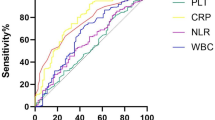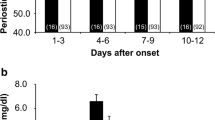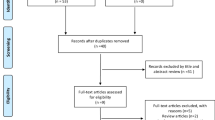Abstract
Inflammatory processes have long been implicated in the development of delayed cerebral ischemia (DCI) following aneurysmal subarachnoid hemorrhage (aSAH). Macrophage migration inhibitory factor (MIF) has been implicated in inflammation. The aim of this study was to assess whether serum levels of MIF at admission helps to predict which patients with aSAH would subsequently develop DCI. All patients with first-ever aSAH admitted between 2016 and 2017 were considered for inclusion in this prospective study. Primary study outcome was development of DCI at discharge. Serum levels of MIF, C-reactive protein (CRP), and interleukin-6 (IL-6) were tested at admission. The relation of serum levels of MIF at admission with DCI was assessed by the logistic regression models. In this study, 201 patients were included. A correlation between Hunt and Hess score and serum levels of MIF was found (r = 0.340; P < 0.001). Fifty-two of the 201 aSAH (25.9%) were defined as DCI, and the obtained MIF level in those patients was higher than in those patients without DCI [26.4 (IQR, 22.6–32.4) ng/ml vs. 20.4 (16.4–24.6) ng/ml; P < 0.001). As a continuous variable, MIF was associated with the risk of DCI. When serum level of MIF was elevated by each 1 ng/ml, the unadjusted risk of DCI was increased by 18% (OR = 1.18 [1.12–1.25], P < 0.001), while the adjusted risk was increased by 10% (1.10 [1.03–1.19], P = 0.001). With the area under the curve (AUC) of 0.780 (95% CI, 0.710–0.849), the MIF showed a great discriminatory ability for DCI than CRP (0.665, 0.582–0.748; P < 0.001) and IL-6 (0.721, 0.642–0.799; P = 0.001). Interestingly, the combined model (MIF/IL-6/CRP) improved the MIF to predict DCI (AUC of the combined model: 0.811; 95% CI, 0.751–0.871; P = 0.024). Furthermore, inclusion of MIF in the existing risk factors for the prediction of DCI enhanced the index and net reclassification improvement (NRI) (P < 0.001) and integrated discrimination improvement (IDI) (P = 0.005) values, confirming the effective reclassification and discrimination. The data showed that elevated MIF serum level accurately identifies patients at highest risk for developing DCI following aSAH.



Similar content being viewed by others
References
Al-Mufti F, Misiolek KA, Roh D, Alawi A, Bauerschmidt A, Park S, ..., Schmidt JM (2018) White blood cell count improves prediction of delayed cerebral ischemia following aneurysmal subarachnoid hemorrhage. Neurosurgery 84(2):397–403
Atangana E, Schneider UC, Blecharz K, Magrini S, Wagner J, Nieminen-Kelhä M, Kremenetskaia I, Heppner FL, Engelhardt B, Vajkoczy P (2017) Intravascular inflammation triggers intracerebral activated microglia and contributes to secondary brain injury after experimental subarachnoid hemorrhage (eSAH). Transl Stroke Res 8(2):144–156
Calandra T, Froidevaux C, Martin C, Roger T (2003) Macrophage migration inhibitory factor and host innate immune defenses against bacterial sepsis. J Infect Dis 187(Supplement_2):S385–S390
Chen S, Feng H, Sherchan P, Klebe D, Zhao G, Sun X, Zhang J, Tang J, Zhang JH (2014) Controversies and evolving new mechanisms in subarachnoid hemorrhage. Prog Neurobiol 115:64–91
Chen YH, Cheng ZY, Shao LH, Shentu HS, Fu B (2017) Macrophage migration inhibitory factor as a serum prognostic marker in patients with aneurysmal subarachnoid hemorrhage. Clin Chim Acta 473:60–64
Crobeddu E, Mittal MK, Dupont S, Wijdicks EF, Lanzino G, Rabinstein AA (2012) Predicting the lack of development of delayed cerebral ischemia after aneurysmal subarachnoid hemorrhage. Stroke 43(3):697–701
Desai M, Morris NA (2018) Prolonged post-traumatic vasospasm resulting in delayed cerebral ischemia after mild traumatic brain injury. Neurocrit Care 29(3):512–518
Drake CG (1988) Report of world Federation of Neurological Surgeons Committee on a universal subarachnoid hemorrhage grading scale. J Neurosurg 68:985–986
Duan W, Pan Y, Wang C, Wang Y, Zhao X, Wang Y, ..., CNSR Investigators (2018) Risk factors and clinical impact of delayed cerebral ischemia after aneurysmal subarachnoid hemorrhage: analysis from the China National Stroke Registry. Neuroepidemiology 50(2–3):128–136
Dziedzic T (2015) Systemic inflammation as a therapeutic target in acute ischemic stroke. Expert Rev Neurother 15(5):523–531
Fassbender K, Hodapp B, Rossol S, Bertsch T, Schmeck J, Schütt S et al (2001) Inflammatory cytokines in subarachnoid haemorrhage: association with abnormal blood flow velocities in basal cerebral arteries. J Neurol Neurosurg Psychiatry 70(4):534–537
Fisher CM, Kistler JP, Davis JM (1980) Relation of cerebral vasospasm to subarachnoid hemorrhage visualized by computerized tomographic scanning. Neurosurgery 6(1):1–9
Foreman B (2016) The pathophysiology of delayed cerebral ischemia. J Clin Neurophysiol 33(3):174–182
Frontera JA, Provencio JJ, Sehba FA, McIntyre TM, Nowacki AS, Gordon E, Weimer JM, Aledort L (2017) The role of platelet activation and inflammation in early brain injury following subarachnoid hemorrhage. Neurocrit Care 26(1):48–57
Galea J, Ogungbenro K, Hulme S, Patel H, Scarth S, Hoadley M, ..., Vail A (2018) Reduction of inflammation after administration of interleukin-1 receptor antagonist following aneurysmal subarachnoid hemorrhage: results of the subcutaneous interleukin-1Ra in SAH (SCIL-SAH) study. J Neurosurg 128(2):515–523
Haegens NM, Gathier CS, Horn J, Coert BA, Verbaan D, van den Bergh WM (2018) Induced hypertension in preventing cerebral infarction in delayed cerebral ischemia after subarachnoid hemorrhage. Stroke 49(11):2630–2636
Hunt WE, Hess RM (1968) Surgical risk as related to time of intervention in the repair of intracranial aneurysms. J Neurosurg 28(1):14–20
Inácio AR, Ruscher K, Leng L, Bucala R, Deierborg T (2011) Macrophage migration inhibitory factor promotes cell death and aggravates neurologic deficits after experimental stroke. J Cereb Blood Flow Metab 31(4):1093–1106
Jeon YT, Lee JH, Lee H, Lee HK, Hwang JW, Lim YJ, Park HP (2012) The postoperative C-reactive protein level can be a useful prognostic factor for poor outcome and symptomatic vasospasm in patients with aneurysmal subarachnoid hemorrhage. J Neurosurg Anesthesiol 24(4):317–324
Kasius KM, Frijns CJM, Algra A, Rinkel GJE (2010) Association of platelet and leukocyte counts with delayed cerebral ischemia in aneurysmal subarachnoid hemorrhage. Cerebrovasc Dis 29(6):576–583
Kwan K, Arapi O, Wagner K, Benziger B, Schneider J, Li C, ..., Ledoux D (2018) Cerebrospinal fluid concentrations of macrophage migration inhibitory factor as a potential biomarker of vasospasm in subarachnoid hemorrhage. J Neurosurg 128(4):56–56
Lee H, Perry JJ, English SW, Alkherayf F, Joseph J, Nobile S, ..., Sinclair J (2018) Clinical prediction of delayed cerebral ischemia in aneurysmal subarachnoid hemorrhage. J Neurosurg. https://doi.org/10.3171/2018.1.JNS172715
Li YS, Chen W, Liu S, Zhang YY, Li XH (2017) Serum macrophage migration inhibitory factor levels are associated with infarct volumes and long-term outcomes in patients with acute ischemic stroke. Int J Neurosci 127(6):539–546
Lin Q, Cai JY, Lu C, Sun J, Ba HJ, Chen MH, Chen XD, Dai JX, Lin JH (2017) Macrophage migration inhibitory factor levels in serum from patients with acute intracerebral hemorrhage: potential contribution to prognosis. Clin Chim Acta 472:58–63
Liu X, Zhan W, Wu Q, Wang F, Yang B, Ou Q (2018) Polymorphism and plasma levels of apolipoprotein E and the risk of aneurysmal subarachnoid hemorrhage in a Chinese population: a case-control study. Lipids Health Dis 17(1):115
Llull L, Thiel S, Amaro S, Cervera Á, Planas AM, Chamorro Á (2017) Ficolin-1 levels in patients developing vasospasm and cerebral ischemia after spontaneous subarachnoid hemorrhage. Mol Neurobiol 54(8):6572–6580
McMahon CJ, Hopkins S, Vail A, King AT, Smith D, Illingworth KJ, Clark S, Rothwell NJ, Tyrrell PJ (2013) Inflammation as a predictor for delayed cerebral ischemia after aneurysmal subarachnoid haemorrhage. Journal of Neurointerventional Surgery 5(6):512–517
Pencina MJ, D'Agostino RB, Vasan RS (2008) Evaluating the added predictive ability of a new marker: from area under the ROC curve to reclassification and beyond. Stat Med 27(2):157–172
Platz J, Güresir E, Wagner M, Seifert V, Konczalla J (2017) Increased risk of delayed cerebral ischemia in subarachnoid hemorrhage patients with additional intracerebral hematoma. J Neurosurg 126(2):504–510
Provencio JJ, Vora N (2005) Subarachnoid hemorrhage and inflammation: bench to bedside and back. Semin Neurol 25(04):435–444
Rabinstein AA, Friedman JA, Weigand SD, McClelland RL, Fulgham JR, Manno EM, Atkinson JLD, Wijdicks EF (2004) Predictors of cerebral infarction in aneurysmal subarachnoid hemorrhage. Stroke 35(8):1862–1866
Sarrafzadeh A, Schlenk F, Gericke C, Vajkoczy P (2010) Relevance of cerebral interleukin-6 after aneurysmal subarachnoid hemorrhage. Neurocrit Care 13(3):339–346
Srinivasan A, Aggarwal A, Gaudihalli S, Mohanty M, Dhandapani M, Singh H, Mukherjee KK, Dhandapani S (2016) Impact of early leukocytosis and elevated high-sensitivity C-reactive protein on delayed cerebral ischemia and neurologic outcome after subarachnoid hemorrhage. World Neurosurg 90:91–95
Teasdale G, Jennett B (1974) Assessment of coma and impaired consciousness: a practical scale. Lancet 304(7872):81–84
Tobin MK, Bonds JA, Minshall RD, Pelligrino DA, Testai FD, Lazarov O (2014) Neurogenesis and inflammation after ischemic stroke: what is known and where we go from here. J Cereb Blood Flow Metab 34(10):1573–1584
Tu WJ, Dong X, Zhao SJ, Yang DG, Chen H (2013) Prognostic value of plasma neuroendocrine biomarkers in patients with acute ischaemic stroke. J Neuroendocrinol 25(9):771–778
Tu WJ, Qiu HC, Zhang Y, Cao JL, Wang H, Zhao JZ, Liu Q, Zeng X (2019) Lower serum retinoic acid level for prediction of higher risk of mortality in ischemic stroke. Neurology 92(15):e1678–e1687
Turtzo LC, Li J, Persky R, Benashski S, Weston G, Bucala R, Venna VR, McCullough LD (2013) Deletion of macrophage migration inhibitory factor worsens stroke outcome in female mice. Neurobiol Dis 54:421–431
Vergouwen MD, Vermeulen M, van Gijn J, Rinkel GJ, Wijdicks EF, Muizelaar JP, ..., Macdonald RL (2010) Definition of delayed cerebral ischemia after aneurysmal subarachnoid hemorrhage as an outcome event in clinical trials and observational studies: proposal of a multidisciplinary research group. Stroke 41(10):2391–2395
Vila N, Castillo J, Dávalos A, Chamorro A (2000) Proinflammatory cytokines and early neurological worsening in ischemic stroke. Stroke 31(10):2325–2329
Wang CW, Ma PJ, Wang YY, Yang M, Su LL, Wang S, Liu YX, Yuan B, Zhao JH (2019) Serum level of macrophage migration inhibitory factor predicts severity and prognosis in patients with ischemic stroke. Cytokine 115:8–12
Wong GKC, Tam YYW, Zhu XL, Poon WS (2014) Incidence and mortality of spontaneous subarachnoid hemorrhage in Hong Kong from 2002 to 2010: a Hong Kong hospital authority clinical management system database analysis. World Neurosurg 81(3–4):552–556
Wu A, Liu R, Dai W, Jie Y, Yu G, Fan X, Huang Q (2015) Lycopene attenuates early brain injury and inflammation following subarachnoid hemorrhage in rats. Int J Clin Exp Med 8(8):14316
Xu T, Pu S, Ni Y, Gao M, Li X, Zeng X (2018) Elevated plasma macrophage migration inhibitor factor as a risk factor for the development of post-stroke depression in ischemic stroke. J Neuroimmunol 320:58–63
Yang DB, Yu WH, Dong XQ, Zhang ZY, Du Q, Zhu Q, ..., Jiang L (2017) Serum macrophage migration inhibitory factor concentrations correlate with prognosis of traumatic brain injury. Clin Chim Acta 469:99–104
Zheng VZ, Wong GKC (2017) Neuroinflammation responses after subarachnoid hemorrhage: a review. J Clin Neurosci 42:7–11
Acknowledgements
We are grateful to the staff in the Emergency Department and Neurological Intensive Care Unit of our hospital for their support with patient recruitment. We are also grateful to the patients who were included in this study.
Author information
Authors and Affiliations
Contributions
Jiang Y had full access to all of the data in the study and takes responsibility for the integrity of the data and the accuracy of the data analysis.
Study concept and design: Yang X, Peng J, Pang J, Wan W, Zhong C, Peng T, Bao K, Jiang Y.
Acquisition of data: Yang X, Peng T, Bao K, Jiang Y.
Analysis and interpretation of data: Peng J, Pang J, Wan W, Zhong C.
Drafting of the manuscript: Yang X, Peng J, Pang J, Wan W.
Critical revision of the manuscript for important intellectual content: Zhong C, Peng T, Bao K, Jiang Y.
Administrative, technical, or material support: Peng J, Pang J, Wan W, Zhong C.
Obtain funding: Yang X.
Study supervision: Jiang Y.
Corresponding author
Ethics declarations
Ethics, Consent and Permissions
Written informed consents were obtained from all patients, and this study conformed to the principles of the Declaration of Helsinki and was approved by the investigational review board of the Affiliated Hospital of Southwest Medical University.
A Consent for Publication
Not applicable.
Conflicts of Interest
The authors declare that they have no conflict of interest.
Additional information
Publisher’s Note
Springer Nature remains neutral with regard to jurisdictional claims in published maps and institutional affiliations.
Rights and permissions
About this article
Cite this article
Yang, X., Peng, J., Pang, J. et al. The Association Between Serum Macrophage Migration Inhibitory Factor and Delayed Cerebral Ischemia After Aneurysmal Subarachnoid Hemorrhage. Neurotox Res 37, 397–405 (2020). https://doi.org/10.1007/s12640-019-00072-4
Received:
Revised:
Accepted:
Published:
Issue Date:
DOI: https://doi.org/10.1007/s12640-019-00072-4




